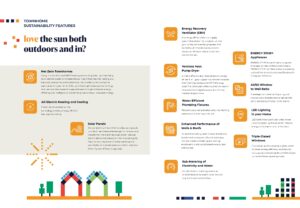Daniels’ Builds Net-Zero Townhomes with Community-Scale Solar

Projects Sponsor
A combination of high efficiency design, all-electric heating and cooling, and local solar power generation makes MPV2 a blueprint for the future of green housing.
One of the main objectives of Daniels’s new MPV2 Net-Zero Townhome Community project was to prove that a net-zero home can be cost-competitive. With MPV2 — the first project built under their Decarbonization Roadmap — Daniels wanted to demonstrate to themselves, their peers in the industry, and the public at large that net-zero townhomes can be delivered today without a material increase in the cost to build and own.

With construction starting in early 2023, MPV2 does that and more — prepare to be home-schooled.
Daniels’ ambitious Decarbonization Roadmap was developed as a direct response to the climate emergency, and the MPV2 homes were built to be a lived-in example that the technologies, and Daniels, are ready to meet the net-zero challenge now.
Daniels’ team researched and prepared long before breaking ground. The use of all the electric heating and cooling technologies and small-scale solar power generation utilized on MPV2 was piloted on a modest 24-unit townhome community in Regent Park, Toronto. This pilot demonstrated to the team that the technologies performed as intended and gave them the confidence to deploy at scale with the MPV2 townhouses.
Lessons were learned from the earlier project; designs were tweaked and made much more ambitious. MPV2 includes 120 stacked townhomes that incorporate community-scale solar with full roof coverage to achieve net-zero energy and operational carbon performance. Importantly, through high-performance design alone, the townhomes achieve a reduction in energy consumption of 50% compared to conventional design.
The use of all-electric systems means that on-site combustion of fossil fuels and associated greenhouse gas emissions have been eliminated entirely. Going fossil-fuel-free in these homes has the additional health and wellness benefits of improved air quality through reduced exposure to combustion off-gases.
Including the benefits from solar generation, the project is designed to achieve net zero energy and carbon emissions by producing as much energy as is consumed in the suites on an annual basis. The project eliminates approximately 135 tonnes of carbon dioxide emissions annually, which is equivalent to driving round-trip from Toronto to Vancouver 21 times per year (as per NRCan Greenhouse Gas Equivalencies Calculator).
Significantly, the Daniels team was also successful in achieving operating cost neutrality for their future homeowners. There is a misconception that all-electric systems will cost much more to operate. By improving the enclosure performance, and selecting high-efficiency equipment, fixtures, and appliances, the annual energy cost is projected to be equal to or less than what you would expect to pay if you were to have a conventional system. By eliminating the gas bill entirely, there are savings to the end user because the hefty monthly customer charges, which can more than offset the increase in electricity consumption, go too.

The publication of a voluntary carbon disclosure label aims to educate public stakeholders around the carbon consequences of their housing choices and increase transparency in the new construction industry and will be deployed across Daniels’ portfolio as they strive to meet the goals in their Decarbonization Roadmap.
The team worked closely with their sales and marketing teams in order to ensure that the benefits and value proposition of a net-zero home could be passed on to purchasers in the simplest, most effective way. To do this, they took the concept of a nutrition facts label that one sees on food packaging and applied this to home building, with the goal that with this tool purchasers can immediately see and start to understand the footprint of their home and the impacts on the environment. Unsurprisingly, demand for the homes was high.

With the successful launch of MPV2, Daniels created a model that can be deployed at scale for future communities and that will inspire other developers to do just that. They’ve built more than just homes – they’ve produced a blueprint for the future of green housing.













